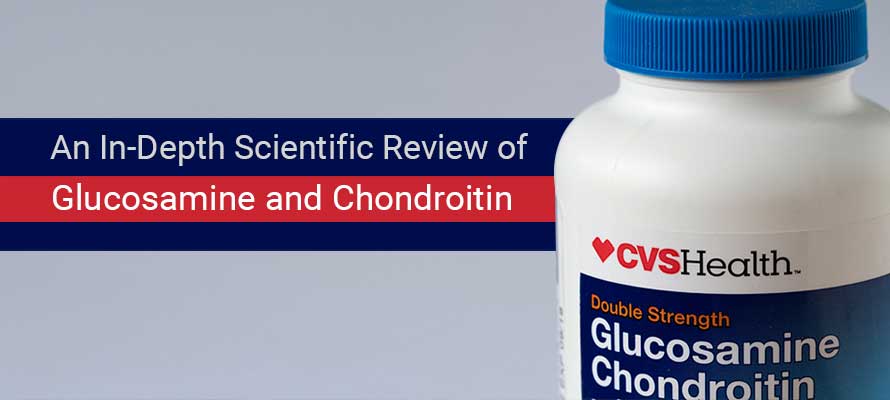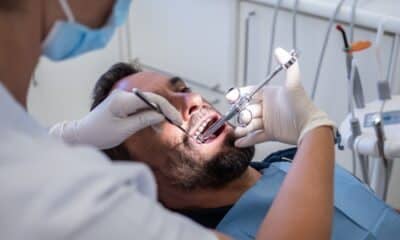Glucosamine and Chondroitin: The Unbiased Scientific Truth, Risks, Side Effects and More…
Each product we feature has been independently selected and reviewed by our editorial team. If you make a purchase using the links included, we may earn a commission.
- Background
- Evidenced-Based Health Benefits
- Risks and Side Effects
- Research
- Conclusion
Over the last 20 years, throughout the world, chondroitin and glucosamine supplementation have been increasingly recommended in guidelines, prescribed by general practitioners and rheumatologists, and used by patients as over-the-counter medications to modify the clinical and radiological course of osteoarthritis, a common type of arthritis that destroys cartilage in the joints, especially in the knees, hips, spine, and hands.
Background of Glucosamine and Chondroitin
Glucosamine and chondroitin are natural materials found in and around the cells of cartilage, the tissue that protects the joints and gives them strength and resilience.
They’re the principal substrates in the biosynthesis of proteoglycans, a set of large protein molecules that compose the ground substance of cartilage and is vital for preserving cartilage integrity. Within Biology, Biology is the most important for the formation of hyaluronic acid, chondroitin sulfate, in addition to keratan sulfate, which is some of the most important components of the extracellular matrix of the articular cartilage and the synovial fluid, which is the fluid that lubricates the joints.
In general, chondroitin sulfate inhibits cartilage destruction processes & stimulates the anabolic processes involved with new cartilage formation; also it has been proven to exert anti-inflammatory activity.
Glucosamine and chondroitin were also developed as pharmaceutical medications for osteoarthritis in Europe and Asia. In the United States and Australia, they’re accessible as over-the-counter supplements and aren’t pharmaceutical grade. Glucosamine and chondroitin may likewise be given through an injection, however, supplementation is the most frequent form of delivery.
Glucosamine is commonly used as either glucosamine hydrochloride or glucosamine sulfate, while chondroitin supplements are typically utilized in the form of chondroitin sulfate.
Evidenced-Based Health Benefits
Major studies have had conflicting results regarding glucosamine and chondroitin, however, supplementation may be beneficial, especially when there is a disturbed balance between catabolic and anabolic processes, such as in osteoarthritis.
In fact, there is significant evidence in the published literature to support the promising disease-modifying osteoarthritis drug potencies of both glucosamine and chondroitin sulfate.
Several studies have shown benefit in the treatment of osteoarthritis with regards to:
-
Pain relief
- In the GAIT (Glucosamine/Chondroitin Arthritis Intervention Trial) study, a large-scale, multicenter clinical trial in the United States, glucosamine combined with chondroitin sulfate supplemented for 8 weeks provided statistically significant pain relief compared with placebo for a subset of participants with moderate-to-severe pain[4][8].
- Findings from in vitro and in vivo studies, clinical trials and meta-analyses show that chondroitin sulfate reduces pain due to its structure-modifying effects.[6][9][10][7]
-
Reduction in joint space narrowing/reduces osteoarthritis progression
- In one systematic review looking at the clinical effectiveness of glucosamine and chondroitin supplements, a reduction in joint space narrowing was consistently observed, however, the effect size was small[11].
- Results from a double-blind randomized placebo-controlled clinical trial also suggested that taking glucosamine sulfate (1,500 mg) in combination with low molecular weight chondroitin sulfate (800 mg) daily for 2 years provided a meaningful reduction in joint space narrowing in people with knee osteoarthritis and evidence of mostly mild radiographic disease[5].
- Another study, called the LEGS study, demonstrated that the combination of glucosamine sulfate and chondroitin sulfate achieved a meaningful reduction in tibio-femoral joint space narrowing over 2 years, compared with placebo[5].
- Findings from many types of studies show that chondroitin sulfate reduces the progression of osteoarthritis by its structure-modifying effects.[6][9][7]
-
Better joint functioning overall
- In several European studies, participants reported that their knees felt and functioned better after taking a large, once-a-day dose of glucosamine sulfate[1].
- One double-blind trial also found that the combination of glucosamine hydrochloride and chondroitin sulfate was as effective as celecoxib (a nonsteroidal anti-inflammatory drug (NSAID) used to treat pain or inflammation) in patients with osteoarthritis of the knee[7].
- Chondroitin sulfate has also been shown to improve the function/mobility of the joint by its structure-modifying effects[6][7].
Results of many studies, including in vivo and in vitro, suggest that both glucosamine and chondroitin sulfate may enhance each other’s efficacy.
Glucosamine and chondroitin may be beneficial for other conditions, however, more research is needed to determine their efficacy. These conditions include, but are not limited to:
- Cataracts (specifically chondroitin)
- Interstitial cystitis (painful bladder syndrome)
- Joint pain
- Kashin-Beck Disease
- Multiple Sclerosis (specifically glucosamine)
- Osteoporosis
- Temporomandibular joint (TMJ) (specifically glucosamine)
- Urinary tract infections (specifically chondroitin)
Risks and Side Effects
While many studies have had favorable results with glucosamine & chondroitin sulfate supplementation, a number of studies have come to mixed decisions and found no advantage at all.
A 2010 evaluation of numerous studies (meta-analysis) found that one of more than 3,800 individuals with osteoarthritis of the knee or hip, therapy with glucosamine, chondroitin, or so the mix was not any better than placebo. In reality, a 2016 research that utilized glucosamine and chondroitin supplementation had to stop early as people taking the supplement reported symptoms compared to those taking a placebo.
Generally, glucosamine and chondroitin are believed to be safe and no severe side effects have been reported in large, well-conducted studies of people taking glucosamine, chondroitin, or both for up to 3 decades.
In the majority of trials, dosages of 1,500 mg every day of glucosamine were used as well as the dose was safe as a placebo and tolerated greater than NSAIDs. Results were similar with chondroitin sulfate as well.
However, as with any medication, there are possible dangers and side effects.
Listed below are some of the side effects reported:
- Upset stomach, diarrhea and abdominal pain
- Heartburn
- Drowsines
- Headaches
- Allergic reactions (especially if you have an allergy to shellfish)
Some other potential risks listed below have been reported from studies but cannot be concluded as more research is needed:
- Glucosamine may increase the risk of glaucoma.
- A study in rats showed that long-term use of moderately large doses of glucosamine might damage the kidneys.
- Glucosamine might affect the way your body handles sugar, especially if you have diabetes or other blood sugar problems, such as insulin resistance or impaired glucose tolerance, however further research is required.
- Avoid taking chondroitin sulfate and glucosamine if you are taking anticoagulants (blood-thinners) or daily aspirin, as it is chemically similar to the blood-thinner heparin.
- Do not use if you are pregnant or nursing and do not use in children.
As with all supplements and medications, check with your doctor or pharmacist before taking glucosamine & chondroitin.
Some dietary supplements may interact with medications or pose risks if you have medical problems or are going to have surgery.
It is also important to note that health insurance usually does not cover these supplements.
Considerations to the Research
Results from randomized trials about the effectiveness of chondroitin and glucosamine are conflicting.
Trials that have reported large effects on joint pain were often hampered by poor study quality and small sample sizes, whereas large methodologically sound trials often found only small or no effects.
It is uncertain why the results of large, well-done studies differ. It may be because of difference in the types of glucosamine used (glucosamine hydrochloride in the NIH study vs. glucosamine sulfate in the European studies), the difference in the way they were administered (one large daily dose in European studies vs. three smaller ones in the NIH study), other differences in the way the studies were done, or chance.
The participants themselves may also play a role in the conflicting results as some patients included in trials were too ill and others were not ill enough. Research bias may also come into play and influence results in studies and should be taken into consideration.
Conclusion
Chondroitin and glucosamine are natural substances in the body, and they are available over the counter as supplements.
They appear to be well-tolerated with no major safety issues and their efficacy seems to range from small to medium treatment effects when it comes to osteoarthritis. However, more research is needed for various conditions.
Results from these supplements are dependent on the individual and therefore glucosamine and chondroitin sulfate supplementation should not be disregarded in treatment.
People with osteoarthritis should work with their health care provider to develop a comprehensive plan for managing their arthritis pain and determine whether glucosamine and chondroitin sulfate is an appropriate treatment option as they are more favorable than the use of NSAIDs, analgesics, and narcotics, especially in elderly individuals with comorbidities.
If you take warfarin or have blood sugar problems, make sure to talk to your doctor about the potential side effects if you are considering or taking glucosamine or chondroitin.
Based on research findings, if you plan on using glucosamine and chondroitin, the dosing recommendation is glucosamine sulfate at 1,500 mg per day in combination with chondroitin sulfate at 800-1,200 mg per day.
The post Glucosamine and Chondroitin: The Unbiased Scientific Truth, Evidenced-Based Health Benefits, Risks, & Side Effects appeared first on.
















